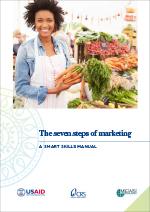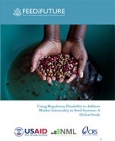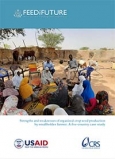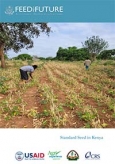Manuals | June 28, 2022
The Seven Steps of Marketing
Marketing is one of the biggest challenges for small-scale farmers in developing countries. Many farmers would like to improve their output or the quality of their products, but they need a way to sell their produce and increase profits.
This manual outlines seven steps that field agents, extension workers and program managers can follow to help farmers improve their marketing. The steps comprise a total of 21 lessons, each with guidelines, exercises to do with a group of farmers or with development agents, and quizzes to test your understanding. The manual is available in English, French, and Spanish, and is also broken into four booklets:
- Getting organized
- Identifying products and organizing groups
- Collecting information for the business plan
- Building a business plan
- Marketing as a group
- Reviewing agro-enterprise performance
- Scaling up
This is one manual in a series on SMART Skills—the skills that field agents need to help farmers in developing countries improve their livelihoods. A companion manual on marketing basics describes the ideas that underlie the seven steps in this manual.
E-LEARNING VERSIONS OF THE CURRICULUM
FOR CRS STAFF
FOR STAFF OF CRS IMPLEMENTING PARTNERS
POWERPOINTS
-
7 Steps of Marketing Booklet 1: Organizing Groups for Marketing - PowerPoint
-
7 Steps of Marketing Booklet 3: Marketing as a Group - PowerPoint
-
7 Steps of Marketing Booklet 4: Reviewing Performance - PowerPoint
FIELD EXERCISES
Exercise 1. Explaining the agroenterprise process
Exercise 2. Visioning “basic sessions”
Exercise 5a. Choosing food products and market products
Exercise 5b. Let’s think about new products
Exercise 5c. Assessing risks of product and marketing options
Exercise 7a. Market mapping
Exercise 7b. Market survey
Exercise 7c. Analyzing market information
Exercise 8. Choosing a production technology package
Exercise 9. Identifying and prioritizing service needs
Exercise 10a. Calculating costs of production and marketing
Exercise 10b. Calculating income and profit
Exercise 11. Calculating the cost of a loan
Exercise 12. Choosing a product and market
Exercise 13a. Visioning
Exercise 13b. Market mapping
Exercise 13c. Problem analysis
Exercise 14. Using the canvas to build a business plan
Exercise 15. Filling in the business plan
Exercise 16. Preparing an implementation plan
Exercise 17a. Working out transportation costs
Exercise 17b. A traders time is the farmers’ money
Exercise 17c. Let’s talk about side-selling
Exercise 18. Farmer and trader pricing
Exercise 19. Calculating costs, income, and profits
Exercise 21. A plan for scaling up





